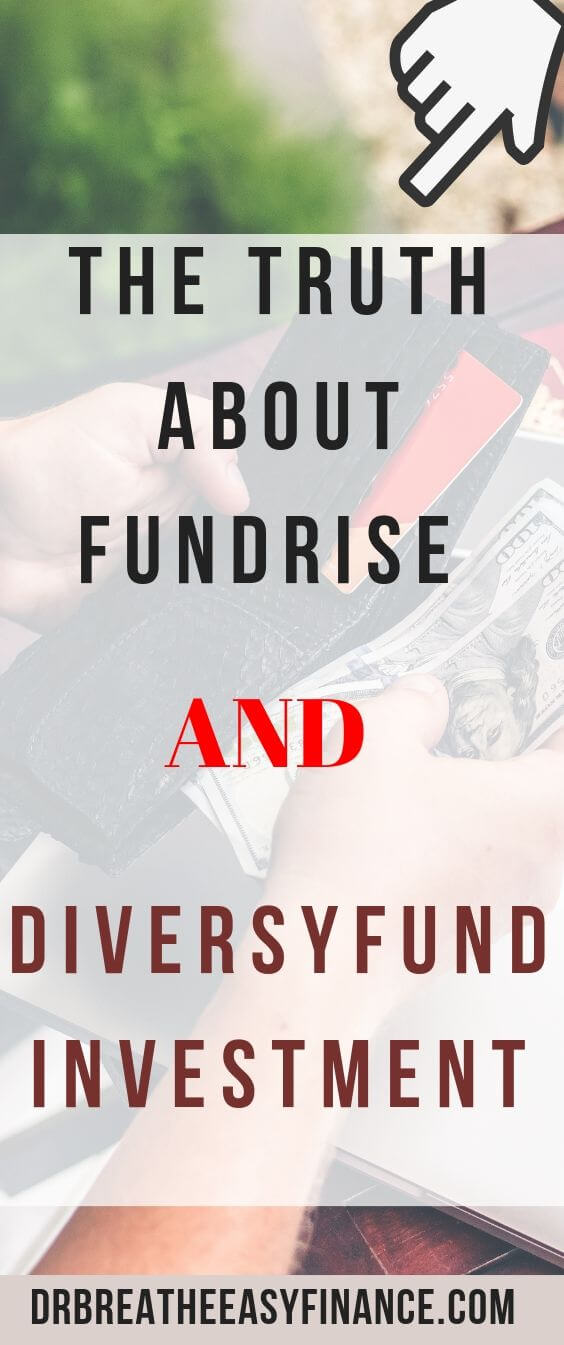Whenever I find a well-written post or informative post, I can’t help myself. Especially if it is about investment. This post will walk you through alternative ways to invest in real estate.
If you’re a reader of personal finance blogs, you know that real estate investing is a hot topic. Bloggers plug and review companies like Fundrise, Realty Mogul, and PeerStreet. A relatively new, but highly competitive fund in this space is DiversyFund. The team at DiversyFund asked the team at The Money Mix to take a look at their fund. We’re glad we did.
What follows is a review of our findings and what we think makes DiversyFund unique in the marketplace. At the end of the post, we think you’ll agree that if you’re considering investing passively in real estate, you should give DiversyFund a look.
With that brief introduction, let’s dive in and take a closer look.
Table of Contents
Publicly Traded REITs
The most common and readily available way to invest in real estate is via real estate investment trusts or REITs (pronounced Reets). REITs purchase a variety of different types of real estate (residential, commercial, multi-family, etc.) Many REITs offer a diversity of these types of real estate in their funds. Most REITs are publicly traded securities offered on stock exchanges via ETFs or mutual funds. The firms offering these REITs must register them with the Securities Exchange Commission (SEC). They are subject to SEC rules and regulations regarding the formation, purchase, and sale of the securities.
The firms that offer them are investment firms. Registration for investment companies offering products is different than those of private investment funds. I’ll explain that shortly.
Private Equity
In the past, private equity real estate funds have only been available to the wealthy. Individuals must be accredited investors to get into the typical fund. Accredited investors are those with at least $200,000 in income ($300,000 joint) or a $1,000,00 net worthy (exclusive of residence). That cuts off the vast majority of the investing public. Only the 1% get into the game. That’s been the biggest complaint and downside of private equity funds.
The other knock on these funds is the high fees. In the beginning, they had what’s called the two and twenty fee structure. That meant investors paid a management fee of 2%. If the fund made profits, management took 20% of the profit. Most people feel those fees are expensive. Competition and public pressure have brought down these fees. They are still among the highest in the industry.
Private equity funds are pooled investment funds, not investment companies. As such, they don’t have to register as investment companies with the SEC. They get what’s called an exempt status under the SEC Private Advisor Rule. In many ways, this is an advantage to the fund and its investors. Complying with the investment company rules is costly and time-consuming. Reporting requirements, in particular, are eased under the Private Advisor Rule.
Some cringe at what they view as the lack of accountability for private advisors. While the larger investors have been pouring billions of dollars into these funds since the started.

Crowdfunded Real Estate Funds
In recent years, crowdfunding has made its way to real estate investing. Crowdfunded REITs are most often offered in private funds; meaning they are not publicly traded. These newer funds register with the SEC as exempt funds, usually under the SEC’s Regulation Crowdfunding. Crowdfunding in real estate, like with individual or small business crowdfunding allows smaller investors into an investment space that hasn’t been available to them in the past.
Both FundRise and DiversyFund are crowdfunded real estate funds. Crowdfunding provides a way for investors with smaller amounts of money to invest in things commonly only available to the wealthy. It’s been a disruptive force in the investment and small business communities. It offers a method of fundraising that can bypass big banks with high rates and fees. In the end, the winners are we consumers. In crowdfunded real estate, non-accredited investors can play in the same playground as the big boys.
With that background, let me tell you about DiversyFund.
DiversyFund Fee Structure
What makes DiversyFund unique is its platform structure. Platform means the arrangement under which the fund raises money, purchases the assets, distributed profits, etc. Many private equity funds hire outside firms to do everything from researching and buying properties to raising money from investors. Every outside entity used for these things has a cost to it. The more outside resources a firm uses, the higher the costs.
DiversyFund is a vertically integrated platform. They do everything in-house. Their team looks for the properties, analyzes them for value, cash-flow, and growth. They buy properties that need upgrades. They handle upgrades as well. Once purchased, they manage the properties themselves. Investors don’t pay brokerage or middle-man fees.
Their website says they are the only real estate fund with no platform fees. I haven’t personally found another one making that claim. Though management and platform fees have dropped, most REITs still have fees. Fees add up and can reduce investor returns. Keeping them low is one of the keys to success.
DiversyFund has that covered.
Fundrise Fee Structure
Fundrise lists its platform fees (Fundrise eDirect) at 1% as follows:
Investment advisor fee – 0.15%
Asset management fee – 0.85%
Additional acquisition fees range from 0% – 2%.
Even at 3%, the Fundrise fees are far below what the traditional private equity fund fees opened to accredited investors charge. Though fees have been reduced from the two and twenty, fees of 1% of assets and 15% of profits are common. Many of these firms can get very creative with their fees.
Crowdfunded platforms like Fundrise and DiversyFund and others are far more transparent with their fees. As you can see, they are much lower than most accreditor investment funds on the market.
Fund Investments
Like with publicly traded REITs, private equity funds can invest in many different types of real estate. Some funds concentrate on commercial properties like small strip shopping centers. Others may focus on residential real estate from single family homes to multi-unit family housing (apartments). Others invest in downtown commercial office space.
Before investing in anything, investors should always know what you’re getting. That’s especially important in real estate. Property location, the type of property, the lease structures, and many other things help determine the return investors receive.
Below I’ll outline the investments Fundrise and DiversyFund make.
DiversyFund Investments
At DiversyFund, they keep things simple. The team believes (and historical returns confirm) that the safest and best performing commercial real estate investments are value-add multi-family units. According to Wikipedia, multi-family units are “multiple separate housing units for residential inhabitants are contained within one building or several buildings within one complex.[1] Units can be next to each other (side-by-side units), or stacked on top of each other (top and bottom units).”
Let’s break this down and see why this matters to investors.
Apartments, townhouses, and the like are more affordable housing than single-family homes in most areas. When the team at DiversyFund researches properties, they look for two important things.
First, the area has to be in an economically growing market. Second, the properties they purchase must be cash-flowing. In other words, they have to be already making money for the owners.
The third part of the decision is where the value-add strategy comes into play. They buy properties that need some improvement. I don’t mean foreclosures or rebuilds. Maybe the units need to be modernized. Perhaps they need some exterior cosmetic enhancements. These improvements allow the fund to increase rents, which increases cash flow, and increases the potential for higher growth in the value of the properties.
The goal of the fund is simple – sell the properties at a highly appreciated price over what they paid for the property and any improvements made — having this as the only focus allows them to focus on the properties that meet these criteria.
They are not trying to be all things to all people. Investors in their fund should be looking for long term capital appreciation.
Fundrise Investments
The Fundrise platform offers three core plans as follows:
Supplemental Income
The goals of the supplemental income fund, as the name suggests, is to produce income. The fund pays out quarterly dividends and invests in income-producing properties. The primary fund investments are in debt real estate assets (real estate loans).
Balanced
The balanced fund’s goal is to offer a blend of both income and growth. To do that, they invest in both debt and equity real estate assets.
Long Term Growth
Dividends and income are not a goal of the long term growth portfolio. Managers are looking for properties to appreciate during the holding period. They don’t invest in debt assets. They only buy hard assets.
Here is a detailed comparison of the three strategies showing the mix of debt vs. equity and the expected returns of each.
What About Liquidity?
Any investments in stocks and real estate should be for the long-term. You should not invest if you need your money in the next year or two. Unlike publicly traded REITs, Fundrise and DiversyFund are private funds. Money invested in them is not liquid. In other words, if you want to get money out before properties get sold or the fund closes, there are restrictions.
DiversyFund Liquidity
Because of the long-term nature of their investments, DiversyFund does not offer liquidity to investors before they sell their properties. High-income and high net-worth investors build wealth by owning and selling properties at a profit. That’s the DiversyFund strategy.
An investor who wants an income from their investments should not invest in DiversyFund. That is not the goal. Investors in this fund need to understand the value of long-term growth on your investments.
Some investors may look at this as a disadvantage I do not. The folks at DiversyFund know who they are and what they want from their real estate. They are not trying to be all things to all people. I like that too. They know who they are and stay true to their strategy.
Fundrise Liquidity
Fundrise investments state that their investment time frame for offerings is five years. They offer no guarantee that they will liquidate in the five years. Investors receive quarterly dividends. Invested capital and capital gains come with the sale of properties.
Investors can take dividends and capital gains in cash or reinvest them.
Investment Risks
Like any investment, crowdfunded real estate has risks. No fund offers guarantees investors will get the results of the past or the expected returns going forward. Nor is there a guarantee investors won’t lose money. There are economic risks in real estate investing. In a slowing economy and bad job market, tenants may not be able to pay their rents. The value of the properties may not appreciate as expected.
Every investor should take into consideration the risks of this or any other investment they make. A general investment principle is this – the higher the expected return of the investment, the higher its expected risk. In other words, risk and return are related.
Accredited investors tend to have higher amounts of money invested in real estate. Why? They can afford to take more risk.
Smaller investors should carefully consider how much they put into real estate, whether publicly traded REITs or private equity funds like Fundrise and DiversyFund.
Final Thoughts
There are many ways to invest in real estate. I hope you have a better understanding of how to do that after this discussion. Private equity investing has been the domain of the wealthy for far too long. Crowdfunded real estate funds open the door to investment previously unavailable to smaller investors.
If you’ve always wanted to get into real estate but felt it was out of your league, Fundrise, DiversyFund and other crowdfunded real estate funds open the door of opportunity for you to do just that.
Diversification is important when investing, whether in stocks, bonds, or real estate. Keep that in mind when considering real estate funds. They may be an excellent addition to your current investment strategy. With $500 minimum investments for these two funds, you can start small and see how it goes for you. Both funds offer ways to add additional money.
My recommendation is to stick with the real estate growth strategy offered by DiversyFund. You’ll be getting a diversified portfolio of well managed, multi-family properties expected to sell at a price higher than the money invested in the properties and improvements on them.
The team has vast experience in this space. The team doesn’t take profits until investors. They manage every aspect of the process from start to finish. There are no platform fees. There are no gimmicks. It’s just good, sound real estate investing.
If you’re thinking about adding money to this asset class, you should take a look at DiversyFund.
This post originally appeared on The Money Mix
Fred Leamnson

The Money Mix








Leave a Reply